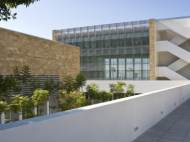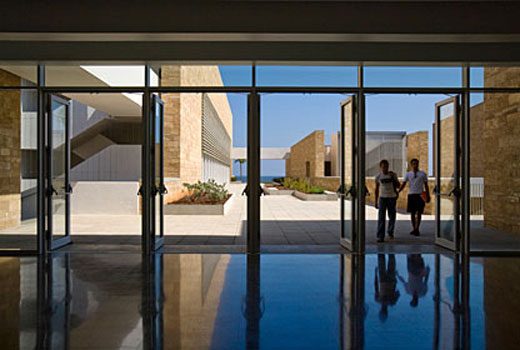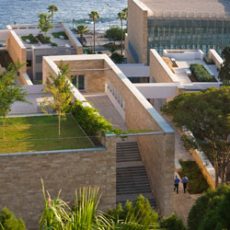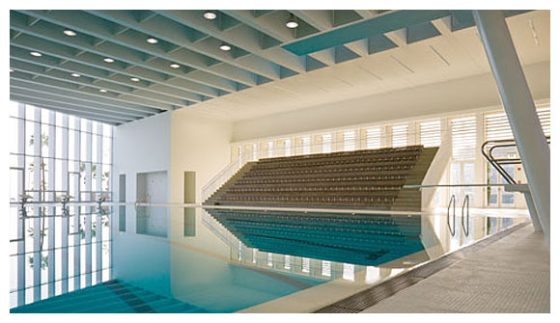Green architecture – Charles Hostler Student Center in Beirut
 In this article we’re going to describe another great architectural achievement made for educational purpose. The Charles Hostler Student Center is in the campus of the American University of Beirut, and it provides a model for environmentally responsive design that meets the social needs of the campus and the larger region. It offers competitive and recreational athletic facilities for swimming, basketball, handball, volleyball, squash, exercise and weight training. The space also includes an auditorium with associated meeting rooms, cafeteria with study space, and underground parking for 200 cars.
In this article we’re going to describe another great architectural achievement made for educational purpose. The Charles Hostler Student Center is in the campus of the American University of Beirut, and it provides a model for environmentally responsive design that meets the social needs of the campus and the larger region. It offers competitive and recreational athletic facilities for swimming, basketball, handball, volleyball, squash, exercise and weight training. The space also includes an auditorium with associated meeting rooms, cafeteria with study space, and underground parking for 200 cars.
Rather than building a single large-scale building and similarly scaled open plaza, the VJAA design firm team proposed multiple building volumes connecting a continuous field of habitable space with gardens on multiple levels. These building volumes are further organized around a network of radial “streets” oriented toward the sea and connected to each other by a series of courtyards, circulation paths, and spectator areas. In order to preserve the significant existing landscape, buildings were sited to maintain existing trees.
The team redesigned the system, value-engineering desalination out of the system and prioritizing seawater cooling from below the site with a low energy absorption chiller. The new absorption chiller runs off a heat source (either steam from waste heat or steam produced by boilers), requiring only a small amount of electricity to run pumps. For AUB, this means a dependable chiller solution that relies on an alternative to electricity during peak demand times. Instead of adding huge chiller equipment to the electrical grid, they either recover some of the heat from their own power generation, or produce steam with boilers. This alternative provides chilled water and cooling for the lower campus.
The planned movement of air and people throughout the project are analogous. Like the pedestrian circulation paths, wind naturally flows between the upper and lower campus. The steep hillside topography of the AUB campus faces north and is densely planted, offering an unusual microclimate. Air cooled by these shaded portions of the campus drops toward the sea during the day, creating a constant cooling and flushing of the air. At night, the site’s prevailing winds are redirected toward the land by its proximity to the Mediterranean Sea.
The design furthermore incorporates radiant cooling for select areas of the buildings where larger gatherings occur on a regular basis, such as the gymnasium, pool, theater, squash courts, and café. Evaporative and radiant cooling are also used in the outdoor courtyard water-walls. On the other hand, the project’s solar panels heat water for the pool and for other uses. Floor piping directs the water into the pool area to warm the floor surfaces. During the summer, the excess thermal energy can be used for chilled water production.
The Hostler Center uses rooftop gardens (green roofs) for social gathering at night. The theater, café, and gymnasium/squash court connect directly to primary rooftop gardens and an amphitheater for evening concerts. In addition to conserving as many existing native trees as possible, new native plantings were added throughout the complex. Sixty-seven percent of interior spaces are day lit, and the large areas of glazing provide significant views of the campus, sea, and mountains beyond. Both competition and spectator areas exit directly onto exterior courtyards.
Storm water is collected through appropriately placed site drains and rooftop landscape surfaces to be reused for irrigation and flushing toilets. Even with this ready source of non-potable water for irrigation, plant materials were still chosen for their drought resistance. Excess storm water is now piped into the municipality’s storm water system. Potable tap water is dedicated for indoor use only – kitchen, lavatories, and showers. Used gray-water from showers and lavatories is collected within a separate piping network and treated in a gray-water plant. Toilets are flushed using clarified gray water and the waste goes to the municipal sewer system.
The Hostler Center uses excess steam produced by AUB to provide additional heating. The ventilation system uses displacement cooling. Large concrete-slab integrated heat exchangers satisfy a major portion of the cooling load. The additional air system provides dehumidified, fresh air. Compared to an all-air system, this system reduces consumption significantly. An advanced water-cooled centrifugal and absorption chiller provides chilled water, heat rejection is through onsite seawater well and heat exchanger. A Building Management System (BMS) operates lighting controls and temperature and humidity controls according to outdoor conditions.
The materials selection process prioritized longevity and local availability. The building’s systems take advantage of local building technologies and materials, including in-situ concrete, stone masonry, terrazzo flooring, and interior plaster. Materials were sourced and manufactured within the local area.












Leave your response!